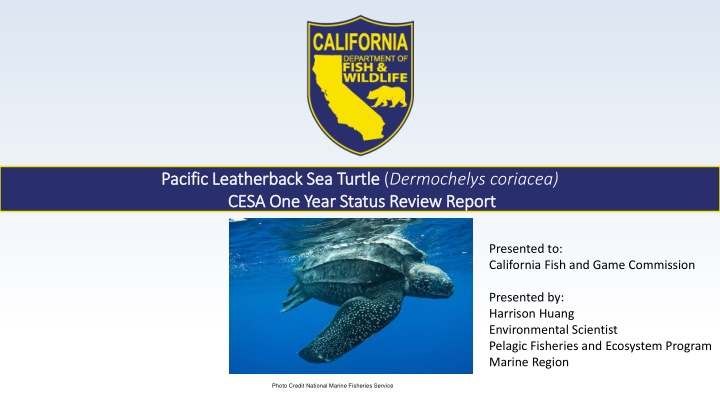
Pacific Leatherback Sea Turtle: Status, Biology, and Conservation Insights
Discover the current status, biology, and conservation efforts surrounding the Pacific Leatherback Sea Turtle, including its size, habitat needs, population trends, and challenges. Learn about its range, nesting habits, and the importance of protecting this endangered species to ensure its survival for future generations.
Download Presentation

Please find below an Image/Link to download the presentation.
The content on the website is provided AS IS for your information and personal use only. It may not be sold, licensed, or shared on other websites without obtaining consent from the author. If you encounter any issues during the download, it is possible that the publisher has removed the file from their server.
You are allowed to download the files provided on this website for personal or commercial use, subject to the condition that they are used lawfully. All files are the property of their respective owners.
The content on the website is provided AS IS for your information and personal use only. It may not be sold, licensed, or shared on other websites without obtaining consent from the author.
E N D
Presentation Transcript
Pacific Leatherback Sea Turtle Pacific Leatherback Sea Turtle (Dermochelys coriacea) CESA One Year Status Review Report CESA One Year Status Review Report Presented to: California Fish and Game Commission Presented by: Harrison Huang Environmental Scientist Pelagic Fisheries and Ecosystem Program Marine Region Photo Credit National Marine Fisheries Service
Listing History Federal ESA June 1970: Listed as endangered California ESA January 2020: Petition submitted to Commission February 2020: Petition received by CDFW 30-day extension approved June 2020: Department Evaluation received by Commission August 2020: Commencement of one-year status review 2
Biology Largest sea turtle species (1.5-2 m, 900 kg) Soft ridged carapace, large flippers Temperature during incubation influences gender Seven distinct subpopulations Source: NMFS & USFWS 2020 3
Range 2 distinct Pacific subpopulations Eastern Pacific Western Pacific A portion of West Pacific stock migrates to North America west coast Forage July-November Source: Benson et al. 2011 4
California Range CA-OR border to U.S.-Mexico border Concentrated sightings in central CA July- November Primary foraging is from Monterey Bay to Point Arena Presence related to seasonal upwelling Jellyfish prey availability No nesting or coming ashore in California 5 Source: Benson et al. 2020
Necessary Habitat Highly migratory species Needs ability to transit Quality foraging areas Pt. Arena to Pt. Arguello is critical habitat Favorable upwelling conditions Quality nesting beaches (OUTSIDE U.S.) Unobstructed and mildly sloped Pristine and sandy Continental shores with deep offshore waters 6
Population Status/Trends 1,277 nesting females1 1984-2011: 5.9% annual decline in Indonesian nesting population2 2001-2017: annual 6.1% decline3 California foraging leatherbacks Current: estimated 55 turtles4 5.6% annual decline from 1990 to 2017, or 80% for the period5 1 NMFS & USFWS 2020 2 Tapilatu et al. 2013 3 Martin et al. 2020 4 Benson, pers. comm 2020 5 Benson et al. 2020 7
Threats to the Population Primarily Outside U.S. Destruction, modification of nesting habitat Legal and illegal take Fisheries bycatch Pollution and vessel strikes Natural disasters and climate change Source: Center for Biological Diversity and Turtle Island Restoration Network 2020 8
Listing Recommendation Listing Pacific leatherback sea turtle as endangered under CESA is warranted 9
Thank You Harrison Huang Environmental Scientist Pelagic Fisheries and Ecosystem Program (562) 342-7199 Harrison.Huang@wildlife.ca.gov Source:https://www.fws.gov/northflorida/SeaTurtles/ Turtle%20Factsheets/leatherback-sea-turtle.htm











